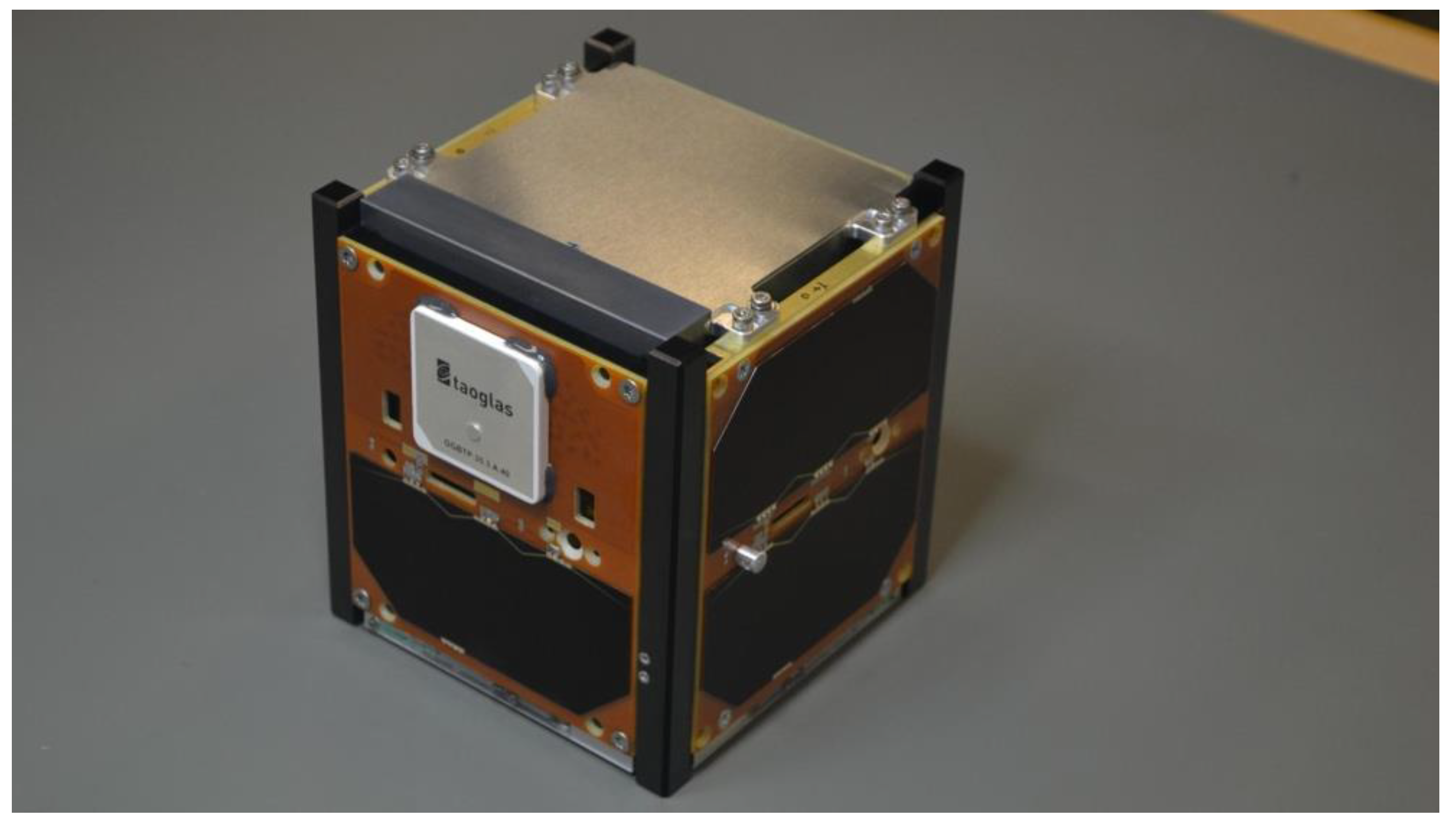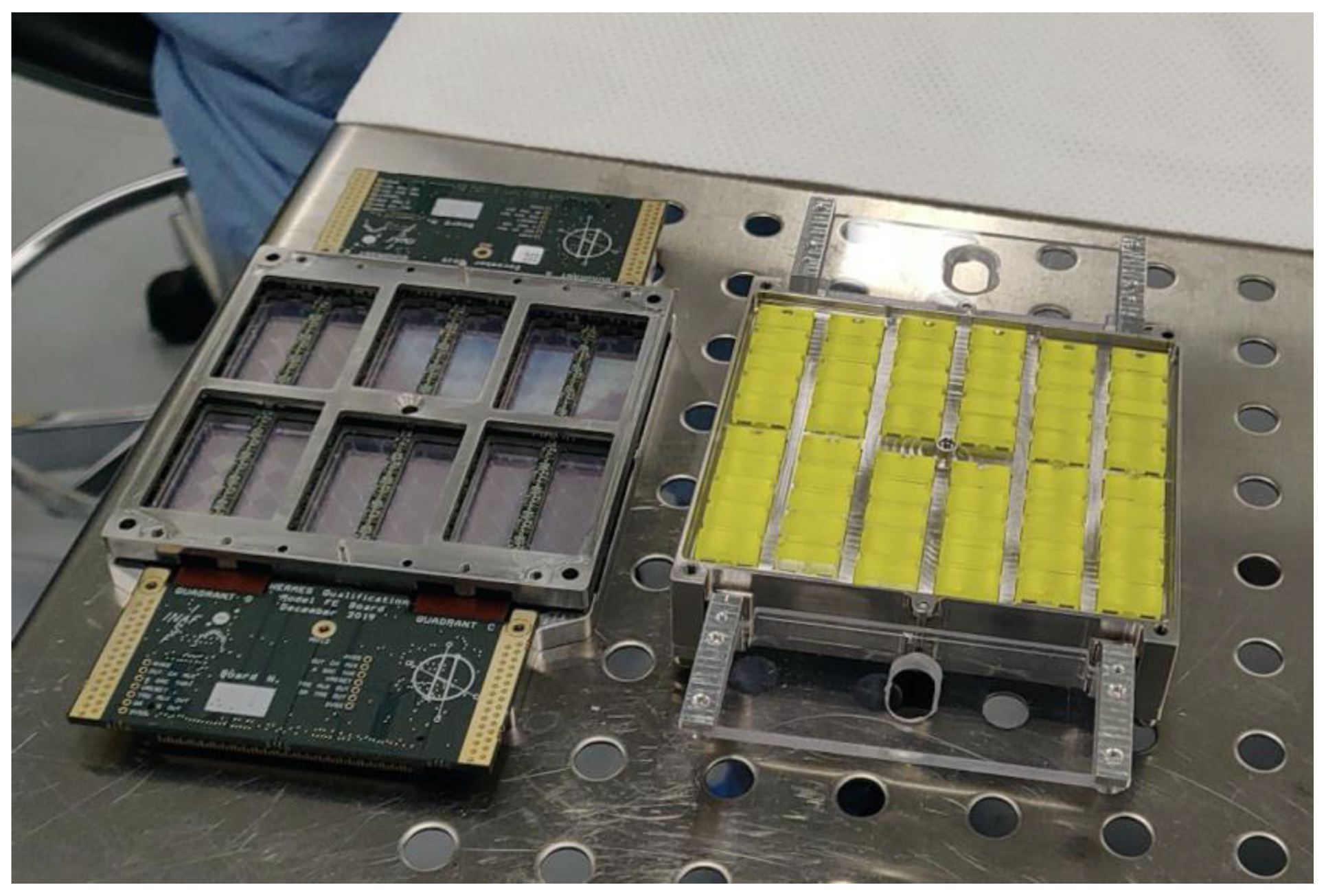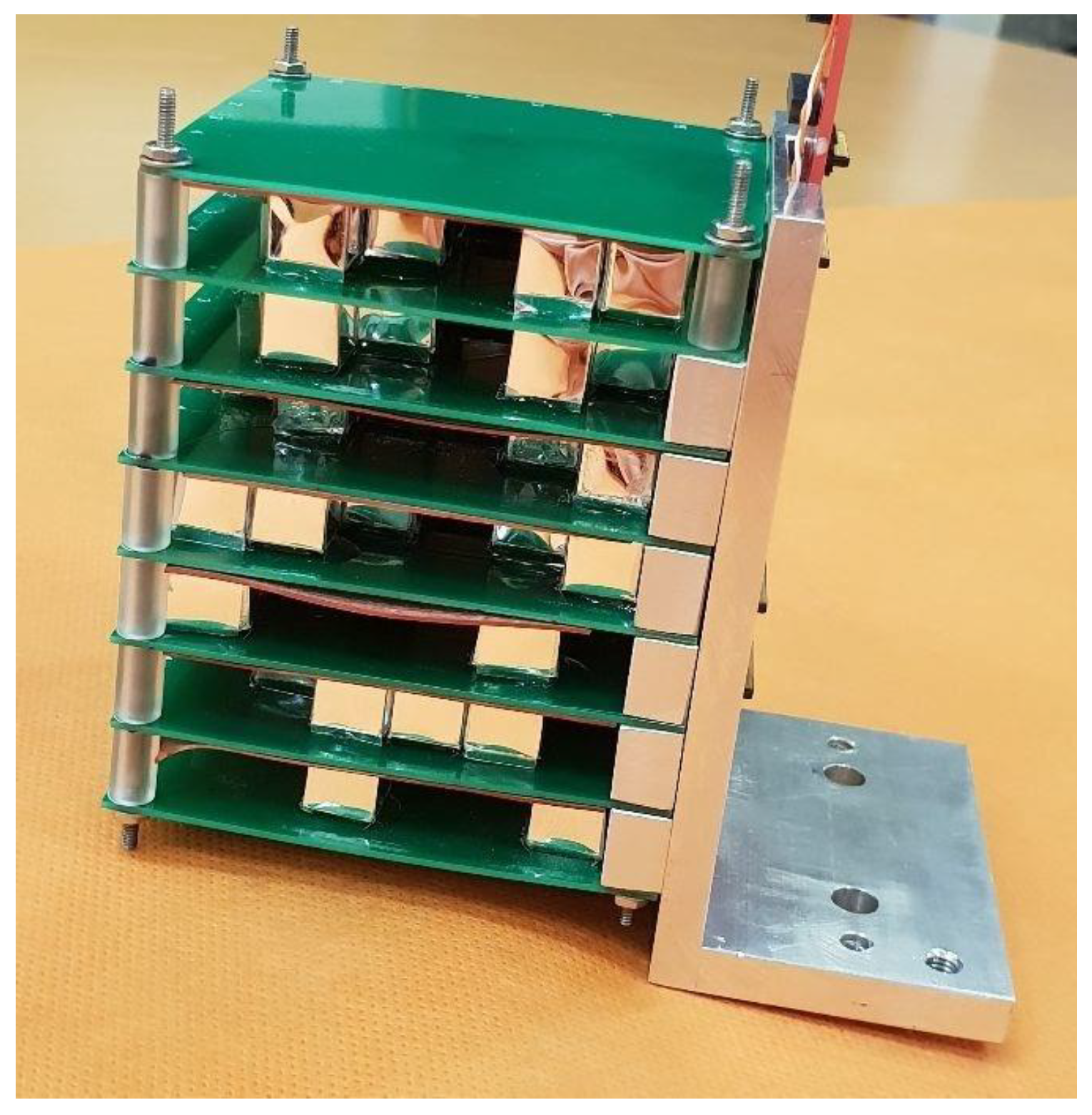Distributed Architectures and Constellations for γ-ray Burst Science
Abstract
:1. Introduction
2. Why Multi-Messenger Astrophysics? What We Want to Learn from Compact Binary Coalescence
- What happens during the merger of compact objects? How frequent is the coincidence with short GRBs; how frequent is the formation of powerful relativistic jets? Non-detections are, in principle, as important as detections. This question is addressed through simultaneous observations and studies of the GW event and the high-energy emission associated with jet production.
- What is the nature of the short GRB’s central engine? What powers the most powerful accelerators of the Universe, NS or BH accretion? The study of the gravitational wave form can distinguish the nature of the remnant. The detection of a short GRB would indicate that a powerful accelerator is in place.
- What is the jet launching mechanism? The delay time between the GW emission and γ-rays emission (the short GRB) can distinguish between different jet launching scenarios [9].
- Do jets have a universal structure or does the structure depend on the type of the compact binary? Perhaps on the mass/spin of the binary components or of the merger remnant? The jet structure can be addressed through both the analysis of the prompt event and its afterglow [10], as well as direct VLBI imaging [11,12]. This requires accurate localizations and follow-up observations from radio to X-rays.
- What is the role of CBCs in the production of heavy elements in the Universe? This requires accurate localizations and follow-up spectroscopic observations from UV to IR.
3. CBC Multi-Messenger Astrophysics Today
4. The Role of Distributed Architectures in Tomorrow’s Multi-Messenger Astrophysics
4.1. A Constellation of Nano-Satelliters for High-Energy Transient Detection and Localization
4.2. A Powerful Combination of Nano- and Micro-/Small Satellites
4.3. An Incomplete List of Pathfinder/Precursor Missions
4.3.1. CAMELOT and GRBAlpha

4.3.2. HERMES Pathfinder
4.3.3. GALI
4.3.4. Other Projects
Author Contributions
Funding
Institutional Review Board Statement
Informed Consent Statement
Data Availability Statement
Acknowledgments
Conflicts of Interest
References
- Klebesadel, R.W.; Strong, I.B.; Olson, R.A. Observations of Gamma-Ray Bursts of Cosmic Origin. Astrophys. J. Lett. 1973, 182, L85. [Google Scholar] [CrossRef]
- Phinney, S.E. Finding and Using Electromagnetic Counterparts of Gravitational Wave Sources. A white paper for the Astro2010 Decadal Review. arXiv 2019, arXiv:0903:0098. [Google Scholar]
- Eichler, D.; Livio, M.; Piran, T.; Schramm, D.N. Nucleosynthesis, neutrino bursts and γ-rays from coalescing neutron stars. Nature 1989, 340, 126–128. [Google Scholar] [CrossRef]
- Nakar, E. Short hard Gamma-ray bursts. Phys. Rep. 2007, 442, 166–236. [Google Scholar]
- Berger, E. Short-Duration Gamma-Ray Bursts. Annu. Rev. Astron. Astrophys. 2014, 52, 43–105. [Google Scholar]
- Nakar, E. The electromagnetic counterparts of compact binary mergers. Phys. Rep. 2020, 886, 1. [Google Scholar] [CrossRef]
- Nakar, E.; Piran, T. Gamma-ray bursts light-curves—another clue on the inner engine. Astrophys. J. Lett. 2002, 572, L139. [Google Scholar] [CrossRef]
- Morsony, B.J.; Lazzati, D.; Begelman, M.C. The origin and propagation of the variability in the outflows of long duration gamma-ray bursts. Astrophys. J. Lett. 2010, 723, 267. [Google Scholar] [CrossRef] [Green Version]
- Lazzati, D.; Ciolfi, R.; Perna, R. Intrinsic Properties of the Engine and Jet that Powered the Short Gamma-ray Burst Associated with GW170817. Astrophys. J. Lett. 2020, 898, 59. [Google Scholar]
- Troja, E.; Piro, L.; Ryan, G.; Van Eerten, H.; Ricci, R.; Wieringa, M.H.; Lotti, S.; Sakamoto, T.; Cenko, S.B. The outflow structure of GW170817 from late-time broad-band observations. Mon. Not. R. Astron. Soc. 2018, 478, L18. [Google Scholar] [CrossRef]
- Mooley, K.P.; Deller, A.T.; Gottlieb, O.; Nakar, E.; Hallinan, G.; Bourke, S.; Frail, D.A.; Horesh, A.; Corsi, A.; Hotokezaka, K. Superluminal motion of a relativistic jet in the neutron-star merger GW170817. Nature 2018, 561, 355. [Google Scholar] [CrossRef] [PubMed]
- Ghirlanda, G.; Salafia, O.S.; Paragi, Z.; Giroletti, M.; Yang, J.; Marcote, B.; Blanchard, J.; Agudo, I.; An, T.; Bernardini, M.G.; et al. Compact radio emission indicates a structured jet was produced by a binary neutron star merger. Science 2019, 363, 968. [Google Scholar] [CrossRef] [PubMed] [Green Version]
- Metzger, B.D. Kilonovae. Living Rev. Relativ. 2019, 23, 1–59. [Google Scholar] [CrossRef] [PubMed] [Green Version]
- LIGO/Virgo Collaborations. GW190425: Observation of a Compact Binary Coalescence with Total Mass∼3.4 M⊙. Astrophys. J. Lett. 2020, 892, L3. [Google Scholar] [CrossRef]
- Chelovekov, I.; Pozanenko, A.; Minaev, P.; Grebenev, S. GCN 2418. 2019. Available online: https://gcn.gsfc.nasa.gov/gcn/ (accessed on 1 December 2021).
- Molkov, S.; Mereghetti, S.; Savchenko, V.; Ferrigno, C.; Rodi, J.; Coleiro, A. GCN 25323. 2019. Available online: https://gcn.gsfc.nasa.gov/gcn/gcn3/25323.gcn3 (accessed on 1 December 2021).
- Palmer, M. GCN 25341. 2019. Available online: https://gcn.gsfc.nasa.gov/gcn3/25341.gcn3 (accessed on 1 December 2021).
- Collaboration, M.A.G.I.C. Teraelectronvolt emission from the γ-ray burst GRB 190114C. Nature 2019, 575, 455. [Google Scholar] [CrossRef]
- Abdalla, H.; Adam, R.; Aharonian, F.; Benkhali, F.A.; Angüner, E.O.; Arakawa, M.; Arcaro, C.; Armand, C.; Ashkar, H.; Backes, M.; et al. A very-high-energy component deep in the γ-ray burst afterglow. Nature 2019, 575, 464. [Google Scholar] [CrossRef] [PubMed] [Green Version]
- Metzger, B.D.; Berger, E. What is the Most Promising Electromagnetic Counterpart of a Neutron Star Binary Merger? Astrophys. J. Lett. 2012, 746, 48. [Google Scholar] [CrossRef] [Green Version]
- Fernandez, R.; Metzger, B.D. Electromagnetic Signatures of Neutron Star Mergers in the Advanced LIGO Era Annual Review of Nuclear and Particle. Science 2016, 66, 23. [Google Scholar]
- Amati, L.; O’Brien, P.; Götz, D.; Bozzo, E.; Tenzer, C.; Frontera, F.; Ghirlanda, G.; Labanti, C.; Osborne, J.P.; Stratta, G.; et al. The THESEUS space mission concept: Science case, design and expected performances. Adv. Space Res. 2018, 62, 191–244. [Google Scholar] [CrossRef] [Green Version]
- Mearns, R.; Trenti, M. Near real-time telecommand solutions for CubeSats: State of the art and applications to the SkyHopper mission. arXiv 2018, arXiv:1808.06746. [Google Scholar]
- Werner, N.; Řípa, J.; Pál, A.; Ohno, M.; Tarcai, N.; Torigoe, K.; Tanaka, K.; Uchida, N.; Mészáros, L.; Galgóczi, G.; et al. CAMELOT: Cubesats Applied for MEasuring and LOcalising Transients-Mission Overview. arXiv 2018, arXiv:1806.03681v1. [Google Scholar]
- Pal, A.; Ohno, M.; Mészáros, L.; Werner, N.; Řípa, J.; Frajt, M.; Hirade, N.; Hudec, J.; Kapuš, J.; Koleda, M.; et al. GRBAlpha: A 1U CubeSat mission for validating timing-based gamma-ray burst localization. arXiv 2020, arXiv:2012.01298. [Google Scholar]
- Ripa, J.; Ohno, M.; Topinka, M.; Pal, A.; Meszaros, L.; Csak, B.; Werner, N.; Topinka, M.; Munz, F.; Hroch, F.; et al. GCN 30624. 2021. Available online: https://gcn.gsfc.nasa.gov/gcn3/30624.gcn3 (accessed on 1 December 2021).
- Ohno, M.; Ripa, J.; Takahashi, H.; Pal, A.; Meszaros, L.; Csak, B.; Werner, N.; Topinka, M.; Munz, F.; Hroch, F.; et al. GCN 30697. 2021. Available online: https://gcn.gsfc.nasa.gov/gcn3/30697.gcn3 (accessed on 1 December 2021).
- Ripa, J.; Ohno, M.; Takahashi, H.; Pal, A.; Meszaros, L.; Csak, B.; Werner, N.; Topinka, M.; Munz, F.; Hroch, F.; et al. GCN 30840. 2021. Available online: https://gcn.gsfc.nasa.gov/gcn3/30840.gcn3 (accessed on 1 December 2021).
- Ripa, J.; Ohno, M.; Takahashi, H.; Pal, A.; Meszaros, L.; Csak, B.; Werner, N.; Topinka, M.; Munz, F.; Hroch, F.; et al. GCN 30946. 2021. Available online: https://gcn.gsfc.nasa.gov/gcn3/30946.gcn3 (accessed on 1 December 2021).
- Ripa, J.; Ohno, M.; Takahashi, H.; Pal, A.; Meszaros, L.; Csak, B.; Werner, N.; Topinka, M.; Munz, F.; Hroch, F.; et al. GCN 30945. 2021. Available online: https://gcn.gsfc.nasa.gov/gcn3/30945.gcn3 (accessed on 1 December 2021).
- Fiore, F.; Burderi, L.; Lavagna, M.; Bertacin, R.; Evangelista, Y.; Campana, R.; Fuschino, F.; Lunghi, P.; Monge, A.; Negri, B.; et al. The HERMES-Technologic and Scientific Pathfinder; Society of Photo-Optical Instrumentation Engineers (SPIE) Conference Series: Washington, DC, USA, 2020; on line only; p. 11444-168. [Google Scholar]
- Sanna, A.; Gambino, A.F.; Burderi, L.; Riggio, A.; Di Salvo, T.; Fiore, F.; Lavagna, M.; Bertacin, R.; Evangelista, Y.; Campana, R.; et al. Timing Techniques Applied to Distributed Modular High-Energy Astronomy: The H.E.R.M.E.S. Project; Society of Photo-Optical Instrumentation Engineers (SPIE) Conference Series: Washington, DC, USA, 2020; on line only; p. 11444-251. [Google Scholar]
- Evangelista, Y.; Fiore, F.; Fuschino, F.; Campana, R.; Ceraudo, F.; Demenev, E.; Guzman, A.; Labanti, C.; La Rosa, G.; Fiorini, M.; et al. The Scientific Payload on-Board the HERMES-TP and HERMES-SP CubeSat Missions; Society of Photo-Optical Instrumentation Engineers (SPIE) Conference Series: Washington, DC, USA, 2020; on line only; p. 11444-168. [Google Scholar]
- Rahin, R.; Moleri, L.; Vdovin, A.; Feigenboim, A.; Margolin, S.; Tarem, S.; Behar, E.; Ghelman, M.; Osovizky, A. GALI a Gamma-ray Burst Localizing Instrument; Society of Photo-Optical Instrumentation Engineers (SPIE) Conference Series: Washington, DC, USA, 2020; on line only; p. 1444-168. [Google Scholar]
- Racusin, J.; Perkins, J.S.; Briggs, M.S.; Nolfo, G.; Krizmanic, J.; Caputo, R.; McEnery, J.E.; Shawhan, P.; Morris, D.; Connaughton, V.; et al. BurstCube: A CubeSat for Gravitational Wave Counterparts. arXiv 2017, arXiv:1708.09292v1. [Google Scholar]
- Murphy, D.; Murphy, D.; Flanagan, J.; Thompson, J.; Doyle, M.; Erkal, J.; Gloster, A.; O’Toole, C.; Salmon, L.; Sherwin, D.; et al. EIRSAT-1 The Educational Irish Research Satellite. In Proceedings of the 2nd Symposium on Space Educational Activities, Budapest University of Economics and Technology (BME), Budapest, Hungary, 11–13 April 2018; Volume 8859. [Google Scholar]
- Wen, J.; Long, X.; Zheng, X.; An, Y.; Cai, Z.; Cang, J.; Che, Y.; Chen, C.; Chen, L.; Chen, Q.; et al. GRID: A Student Project to Monitor the Transient Gamma-Ray Sky in the Multi-Messenger Astronomy Era. arXiv 2019, arXiv:1907.06842v1. [Google Scholar] [CrossRef] [Green Version]
- Wang, Y.; Zheng, X.; Xiao, S.; Yang, J.; Liu, Z.-K.; Yang, J.-H.; Zhang, B.-B.; Zeng, M.; Xiong, S.-L.; Feng, H.; et al. GRB 210121A: A Typical Fireball Burst Detected by Two Small Missions. Astrophys. J. Lett. 2021, 922, 237. [Google Scholar] [CrossRef]



Publisher’s Note: MDPI stays neutral with regard to jurisdictional claims in published maps and institutional affiliations. |
© 2021 by the authors. Licensee MDPI, Basel, Switzerland. This article is an open access article distributed under the terms and conditions of the Creative Commons Attribution (CC BY) license (https://creativecommons.org/licenses/by/4.0/).
Share and Cite
Fiore, F.; Werner, N.; Behar, E. Distributed Architectures and Constellations for γ-ray Burst Science. Galaxies 2021, 9, 120. https://doi.org/10.3390/galaxies9040120
Fiore F, Werner N, Behar E. Distributed Architectures and Constellations for γ-ray Burst Science. Galaxies. 2021; 9(4):120. https://doi.org/10.3390/galaxies9040120
Chicago/Turabian StyleFiore, Fabrizio, Norbert Werner, and Ehud Behar. 2021. "Distributed Architectures and Constellations for γ-ray Burst Science" Galaxies 9, no. 4: 120. https://doi.org/10.3390/galaxies9040120
APA StyleFiore, F., Werner, N., & Behar, E. (2021). Distributed Architectures and Constellations for γ-ray Burst Science. Galaxies, 9(4), 120. https://doi.org/10.3390/galaxies9040120





